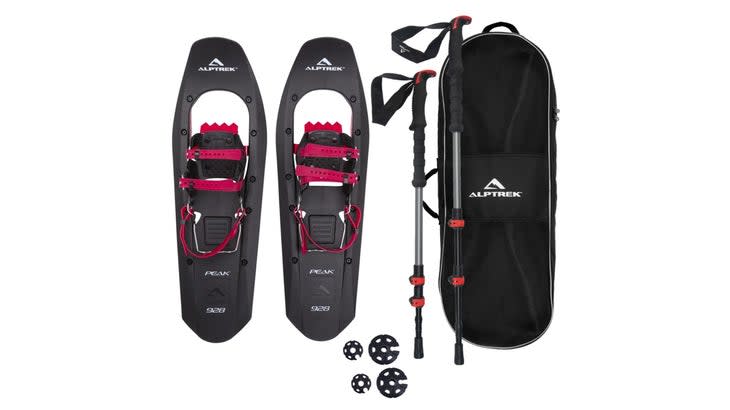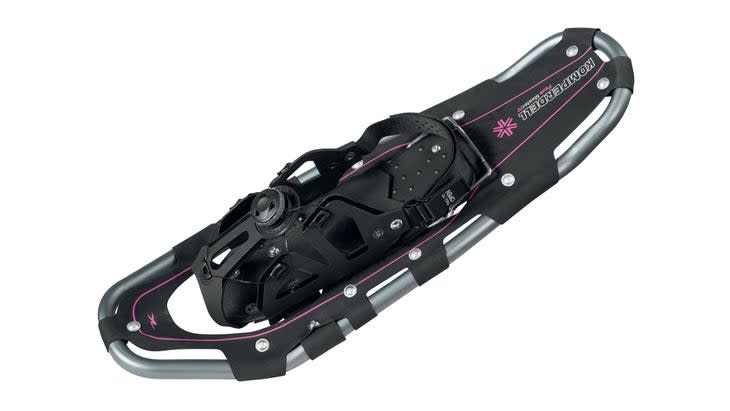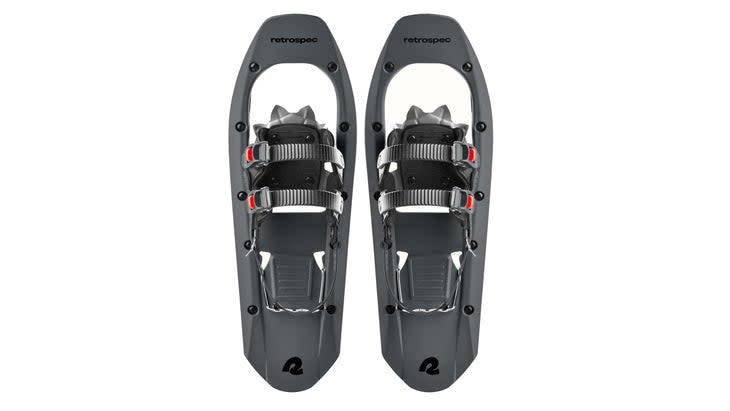The Best Snowshoes of 2024
This article originally appeared on Outside
Snowshoes are some of the oldest winter tech around with--literally--prehistoric origins. Despite the many evolutions in its humble design, snowshoes manage to improve every year, granting more flotation, providing better grip, and weighing less on our feet and in our packs. This winter's crop is no exception.
The Winners at a Glance
Video loading...
Best Bang for Your Buck: Cascade Mountain Tech Alptrek Peak Snowshoe Kit
Best Binding: Komperdell Peakmaster Pro Snowshoe
Best Grip: Retrospec Drifter Plus
The Reviews: The Best Snowshoes of 2024
Best Bang for Your Buck: Cascade Mountain Tech Alptrek Peak Snowshoe Kit ($80)

Pros: Easy on/easy off, comes with poles and storage bag, lightweight
Cons: Hard to strap to your pack, heel lift is tough to pull
Sizes: 22.8, 25.2, 28 in
Weight: 2.3 lbs (25.25 in)
Our eastern Oregon-based tester, Mary Emerick, praised these shoes for keeping her afloat and stable on icy slopes, and found that their performance beat out some more expensive pairs. 57 variously-sized metal points along the 16-inch outside edges combined with seven toe spikes provided superior traction. On trails around the Redmont Ski Shelter in Oregon's Wallowa-Whitman National Forest, the 'shoes allowed her to "charge up a hill of death in a way I've never been able to with fancier snowshoes. I could walk right up instead of making switchbacks," she says. "And usually I have to slide down the hill on my butt on the way out, but I could walk right down with these shoes," says Emerick. She also complimented the on/off process, that employs three thick, easy-to-use rubber straps that span across the foot and heel. The Alptrek Peak's are made of a lightweight composite deck, while the included aluminum poles have extended grips, a quick-lock system, and large snow baskets--not bad for a budget kit. Emerick also loved that the stainless steel crampons were coated blue and matched the blue straps, because, "fashion is everything while snowshoeing, right?"
Best Binding: Komperdell Peakmaster Pro Snowshoe ($220-$240)

Pros: Affordable, simple BOA binding, perfect balance of float and traction
Cons: Heel lift sticks, no traction along the sides
Sizes: 22, 25, 30 in
Weight: 2 lbs (25 in)
Our Alaska-based testers loved the efficiency and security of the Quicklock BOA-style binding and quick-release nylon heel strap in combination with thick rubber sides that engulfed their feet. That tight wrap was especially useful while exploring remote areas outside Denali National Park, Alaska, where it dipped into the -30s at night. In such bitter cold, testers also appreciated the bonus neoprene snowshoe toe cover ($40 extra) that snaps onto the side of the binding and zips over toes, keeping their feet warm while preventing snow from piling up. With a strong aluminum frame and tough rubber decking, the Peakmaster Pros are best for deep, powdery snow where ample floatation is needed. These 'shoes hold their own on icy, snow-packed slopes too, thanks to seven large teeth and a serrated, U-shaped stainless steel heel piece that provides traction. The only ding? It takes muscle to push the heel lift back down into place.
Best Grip: Retrospec Drifter Plus ($100)

Pros: Impressive traction, easy bindings, affordable
Cons: Noisy, relatively low weight limit
Sizes: 23, 25 in
Weight: 2.5 lbs (25 in)
The 70-plus, variously sized steel teeth that span almost the entire length of the Retrospec Drifter Plus, paired with the seven steel toe crampons, provided our Montana-based tester, Tanner Smithwick, plenty of grip along the Sypes Canyon Trail in Gallatin County. Smithwick appreciated the molded plastic deck that proved durable while maintaining flex, and noted that the pivoting footbed motion felt natural while trekking through deep snow in the Beehive Basin Trail in Big Sky, even on his giant size 12 feet. He also praised the double ratchet straps that locked in the upper foot, and the rubber heel strap, which kept his heel in place. "They are easy to put on, take off, and adjust on-the-go," he says. "No need to sit down and take your gloves off." Smithwick's only gripe? The molded plastic decking makes a very loud "smack" noise when moving quickly on flatter terrain.
How to Buy Snowshoes
Flat, uncomplicated terrain doesn't require too much from a pair of snowshoes. Simple, comfortable bindings and a deck that provides adequate flotation are all you need. If icy slopes or deep snow aren't in your future, save money with a budget pair made from heavier molded plastic and less aggressive traction.
On the other end of the spectrum are snowshoes built for challenging terrain--slushy hills to mixed rock and ice. A secure wrap or multiple straps along the foot are important for stability. Quick binding systems, like those that utilize a BOA twist lock, are helpful when taking snowshoes on and off in precarious terrain and a huge time-saver compared with fiddly three-strap setups. Snowshoes geared towards mountainous ascents will have a wider variety of spikes and crampons--and in more abundance--to offer grip both horizontally and laterally, and to bite through different types of ice. A heel lift (that can easily be flicked open and closed) is a must for giving your feet and calves an assist on the steeps.
In deep, fresh powder, you'll want wider, longer snowshoes (or those that come with extensions) for superior flotation in deep snow. On the flipside, if you're headed out on a weight-conscious backpacking trip, prioritize lightweight construction, like a pair made from aluminum and TPU-coated nylon, for fatigue on-foot and outside your pack.
How We Test
Number of testers: 9
Number of products tested: 10
Miles logged while testing: 166 miles
States we tested in: Alaska, Washington, Montana, Oregon, California
Coldest temperature: -32 degrees
Our testers ventured out to some of the coldest and snowiest states to test 10 pairs of newfangled snowshoes. We looked at design, features, ease of use, comfort, traction, cost, weight, and floatation in deep snow to narrow down the best of the best. Only three models stood up to the rigors of our testing by the end of the season.
Meet Our Lead Testers
Justin La Vigne
Our category manager, Justin La Vigne, lives a "life less ordinary" just outside of Denali National Park and Preserve in Alaska. When not writing, he is a professional backcountry guide, taking people hiking and backpacking all over Alaska, and has personally logged 7000+ trail miles. He embraces the cold, snowy, and dark winters that start in September and last until May. He has snowshoes stationed at his front door and uses them daily for getting around his property and exploring the frozen landscape of Alaska A core group of about 25 testers from all over the world help him vet out the best of the best in the field.
Mary Emerick
Mary Emerick hails from the Wallowa Mountains of Eastern Oregon, where she has been testing snowshoes and traction for four years now and other gear for more than 10 years. She is currently a recreation planner for the US Forest Service, and an author of several books. Her past jobs include a wildland firefighter, naturalist and wilderness ranger. When not working, she can be found exploring the outdoors year round with her dogs and penning a new novel. She loves gear testing, as she gets to discover new brands she never heard of and incorporate them into her gear collection. Her favorite places to test are on the Pacific Crest Trail, Hells Canyon, and the Grand Canyon.
For exclusive access to all of our fitness, gear, adventure, and travel stories, plus discounts on trips, events, and gear, sign up for Outside+ today.

